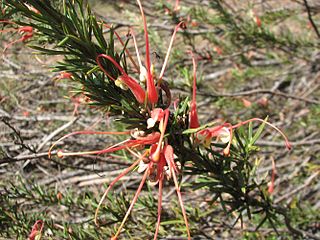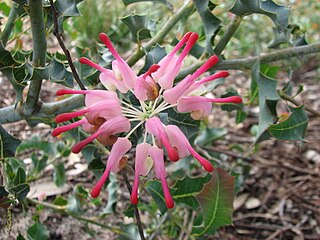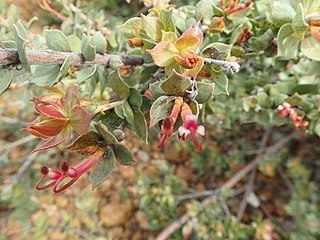
Grevillea vestita is a species of flowering plant in the family Proteaceae and is endemic to the southwest of Western Australia. It is an erect, spreading, prickly shrub with lobed leaves, the number and arrangement of lobes depending on subspecies, and more or less spherical to dome-shaped clusters of hairy, white to cream-coloured flowers sometimes tinged with pink.

Grevillea flexuosa, commonly known as zigzag grevillea or tangled grevillea, is a species of flowering plant in the family Proteaceae and is endemic to the south-west of Western Australia. It is an erect shrub with divided leaves, these lobes with three to five triangular lobes, and cylindrical clusters of cream-coloured to pale yellow flowers.

Grevillea leucopteris, also known as old socks or white plume grevillea, is a species of flowering plant in the family Proteaceae and is endemic to the south-west of Western Australia. It is a spreading, bushy shrub with divided leaves with erect, linear lobes and clusters of white to cream-colured flowers displayed above the foliage.

Grevillea umbellulata is species of flowering plant in the family Proteaceae and is endemic to the south-west of Western Australia. It is a spreading shrub that forms a lignotuber, has linear to narrowly elliptic leaves, and cylindrical clusters of hairy, white to cream-coloured flowers often tinged with grey or pink.

Grevillea candicans is a species of flowering plant in the family Proteaceae and is endemic to the south-west of Western Australia. It is a bushy shrub with pinnately-divided leaves with sharply-pointed linear lobes, and cream-coloured flowers.

Grevillea paniculata, commonly known as kerosene bush, is a species of flowering plant in the family Proteaceae and is endemic to the south-west of Western Australia. It is a dense shrub with divided leaves, the lobes linear, and more or less spherical clusters of white to cream-coloured flowers.

Grevillea drummondii, commonly known as Drummond's grevillea, is a species of flowering plant in the family Proteaceae and is endemic to the south-west of Western Australia. It is a low, spreading to erect shrub with narrowly elliptic to narrowly egg-shaped leaves with the narrower end towards the base, and dense groups of cream-coloured flowers that turn pink or red as they age.

Grevillea didymobotrya is a species of flowering plant in the family Proteaceae and is endemic to the south-west of Western Australia. It is an erect shrub with simple leaves, the size and shape depending on subspecies, and cylindrical groups of yellow or cream-coloured flowers.

Grevillea acrobotrya is a species of flowering plant in the family Proteaceae and is endemic to the southwest of Western Australia. It is a prickly, spreading to erect shrub with egg-shaped to trowel-shaped leaves with sharply-tipped lobes, and white to cream-coloured flowers with smaller leaves at the base.

Grevillea tripartita is species of flowering plant in the family Proteaceae and is endemic to the south-west of Western Australia. It is an erect, prickly shrub with divided leaves with 3 lobes, and clusters of red and cream-coloured or reddish-orange and yellow flowers.

Grevillea diversifolia, the variable-leaved grevillea, is a species of flowering plant in the family Proteaceae and is endemic to the south-west of Western Australia. It is an erect to prostrate shrub with simple or divided leaves and groups white to cream-coloured flowers with a dull red style.

Grevillea insignis, commonly known as wax grevillea, is a species of flowering plant in the family Proteaceae and is endemic to the south-west of Western Australia. It is an erect, bushy shrub with more or less oblong leaves with seven to seventeen sharply-pointed, triangular teeth, and more or less spherical or cylindrical clusters of cream-coloured flowers ageing to pink.

Adenanthos venosus is a species of flowering plant in the family Proteaceae and is endemic to a restricted part of the southwest of Western Australia. It is an openly-branched shrub with clustered egg-shaped leaves and reddish flowers.

Grevillea brachystachya, commonly known as short-spiked grevillea, is a species of flowering plant in the family Proteaceae and is endemic to the south-west of Western Australia. It is a bushy shrub with linear leaves and more or less spherical clusters of cream-coloured to greenish flowers.

Grevillea candolleana, commonly known as the Toodyay grevillea, is a species of flowering plant in the family Proteaceae and is endemic to a restricted part of the south-west of Western Australia. It is a shrub with narrow egg-shaped to linear leaves and white to cream-coloured flowers.

Grevillea commutata is a species of flowering plant in the family Proteaceae and is endemic to the west of Western Australia. It is a spreading, open to dense shrub with egg-shaped leaves with the narrower end towards the base, and white, cream-coloured, and pinkish-green flowers.
Grevillea makinsonii is a species of flowering plant in the family Proteaceae and is endemic to the south-west of Western Australia. It is an erect shrub with egg-shaped to more or less spatula-shaped leaves, and clusters of cream-coloured to pale yellow flowers.

Grevillea shuttleworthiana is a species of flowering plant in the family Proteaceae and is endemic to the south-west of Western Australia. It is a more or less erect shrub with variably-shaped leaves, the shape depending on subspecies, and cylindrical clusters of cream-coloured to yellow or greenish flowers, often held above the foliage.

Petrophile conifera is a species of flowering plant in the family Proteaceae and is endemic to southwestern Western Australia. It is a bushy, much-branched shrub with pinnate, sharply-pointed leaves, and oval heads of hairy, cream-coloured to yellowish white flowers.

Pimelea floribunda is a species of flowering plant in the family Thymelaeaceae and is endemic to the south-west of Western Australia. It is a shrub with narrowly elliptic to egg-shaped leaves arranged in opposite pairs, and drooping, head-like clusters of white or cream-coloured, tube-shaped flowers.



















